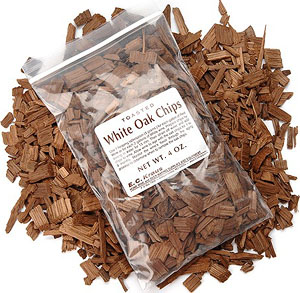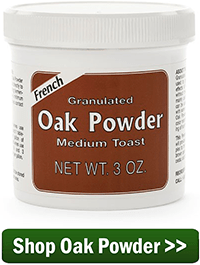 I’ve started my first batch of wine using the toasted oak chips, added after the primary fermentation. I am wondering if during the racking process about to be done after the secondary fermentation, do I transfer the oak chips too?
I’ve started my first batch of wine using the toasted oak chips, added after the primary fermentation. I am wondering if during the racking process about to be done after the secondary fermentation, do I transfer the oak chips too?
Name: Debra M.
State: Tennessee
Hello Debra,
Adding oak chips, that have been sap cleared and toasted, directly to the wine has long been one of the tricks up the home winemaker’s sleeve. It allows you to enjoy all the advantages of barrel-aging your wine without the cost or work of using and actual wine barrel.
These toasted oak chips are made from white oak that has been kilned to sap clear and then toasted to raise the woods sweetness to the outer surface of the chip. This toasting is no different than what is done to the inside of a wine barrel.
Typically, we recommend adding oak chips after the fermentation has completed and the wine has cleared. The wine is bulk-aged in something like a carboy along with the oak chips for a matter of weeks to months. You can sample the wine along the way to determine when you would like to take the chips out.
Adding the oak chips during the primary fermentation is okay, however you do not have as much control over the flavor when using this method. It’s hard to know if the wine needs more time on the chips or not. This is because you do not know what the wine is going to taste like at that point in the process.
The only exception to this argument is when you are making wine with a wine ingredient kit. Normally, these kits will instruct you to put the oak chips in the primary fermentation, just as you have done, and then remove them when racking the wine into a secondary fermenter. This method is okay in this situation because the producers of these wine ingredient kits already know exactly how much oak chip is needed in the primary fermentation to end up with a wine in good balance. They have already determined this by bench-testing several batches with varying quantities of oak.
situation because the producers of these wine ingredient kits already know exactly how much oak chip is needed in the primary fermentation to end up with a wine in good balance. They have already determined this by bench-testing several batches with varying quantities of oak.
If you are not making a wine from a wine ingredient kit, then I would suggest taking the toasted oak chips out of the wine must at this point. You may already have more oak impression in the wine than you like. You have no way of knowing with a wine in progress. Once the fermentation has completed and the wine has cleared, then you can revisit the possibility of adding toasted oak chips at that time for further aging.
Happy Winemaking,
Ed Kraus
—–
Ed Kraus is a 3rd generation home brewer/winemaker and has been an owner of E. C. Kraus since 1999. He has been helping individuals make better wine and beer for over 25 years.

Is there a rule about oak chips lightly toasted to heavy toasted to use?
Rick, if you are talking about which wine to use each with: the bigger the wine the more toast that you will want to the chips to have. This is a generalization, of course. If you are talking about substituting one for the other, there is no rule. One is not stronger than the other. Each has it’s own distinct effect that it adds to the wine, therefore substitution is not possible.
Is there a rule of thumb to add ok chips to wine ? I have a gallon of Chilean Malbec . Fermentation is complete, I’ve racked one time and am now waiting for clearing. How much oak chips for how long would you recommend ?
Thanks for this! I have a wine making kit that has oak chips added in the fermentation stage. It’s not really giving me the oak I’m looking for. Can I add more in the racking stage?
Tim, you can add more oak if you prefer. However, remember that the longer the oak is in contact with the wine the more oak flavor you will receive.
Thanks!